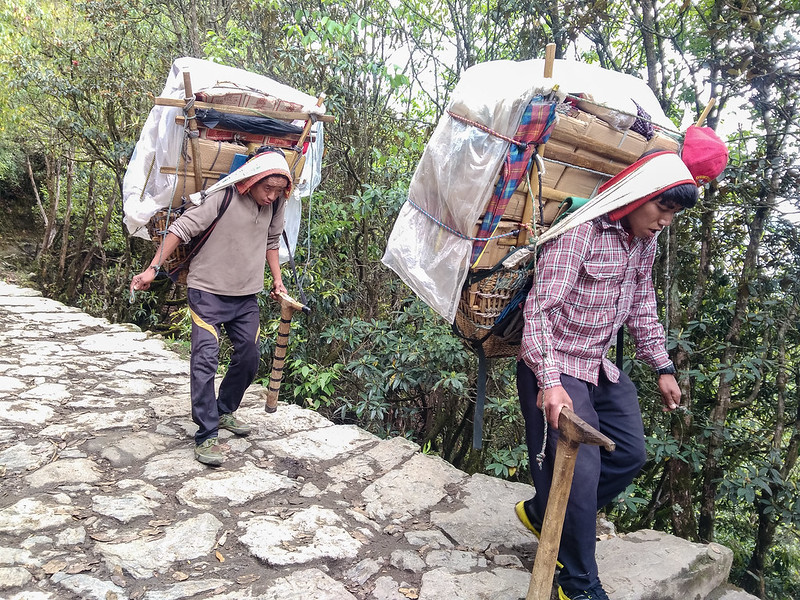Guardians of Everest: Poverty Amongst Sherpas
 The Sherpa people, nestled in the majestic peaks of the Himalayas, have long been synonymous with mountaineering prowess. Yet, behind the façade of adventure and glory lies a harsh reality: the pervasive poverty and exploitation faced by these indigenous mountain communities. In 2023, the Fourth Nepal Living Standards Survey reported that Nepal had a poverty rate of 20.27%. Currently, an intricate web of factors contributes to poverty amongst Sherpas, primarily stemming from exploitation within the adventure industry.
The Sherpa people, nestled in the majestic peaks of the Himalayas, have long been synonymous with mountaineering prowess. Yet, behind the façade of adventure and glory lies a harsh reality: the pervasive poverty and exploitation faced by these indigenous mountain communities. In 2023, the Fourth Nepal Living Standards Survey reported that Nepal had a poverty rate of 20.27%. Currently, an intricate web of factors contributes to poverty amongst Sherpas, primarily stemming from exploitation within the adventure industry.
A Legacy of Mountaineering Excellence
For generations, Sherpas have served as the unsung heroes of Himalayan expeditions, guiding climbers through treacherous terrain and shouldering the burdens of the ascent. Renowned for their unparalleled strength, resilience and intimate knowledge of the mountains, Sherpas play an indispensable role in facilitating the conquest of some of the world’s highest peaks.
Moreover, Mount Everest, known as Sagarmatha in Nepal, has become a bucket-list expedition for some and often requires a Sherpa guide to navigate the tough terrain. As a result, the central Sherpa community has undergone a lasting alteration of its cultural practices and means of sustenance. According to The Kathmandu Post, tourism employs 11.5% of the Nepals workforce— about 370,000 people. The majority of Sherpas work within this industry.
Disparity in Compensation
Despite their indispensable contributions, Sherpas often find themselves at the short end of the economic stick. While expedition leaders and adventure companies reap substantial financial rewards from high-priced mountaineering expeditions, Sherpas receive meager wages for their laborious work. This vast disparity in compensation underscores the exploitative dynamics within the adventure industry, where Sherpa labor is undervalued and under-compensated. According to National Geographic, a guided hike to Everest can cost anywhere between $30,000 and $120,000.
We Are Reckless reported that on average, Sherpa guides only make around $4000 for the whole climbing season. Furthermore, it noted that guides with Western backgrounds make around $50,000 comparatively. In fact, the wage gap between Western guides and Sherpa guides emphasizes the lack of regard for Sherpa’s lives that the tourism industry has and brings to light the reality of poverty among Sherpas.
Occupational Hazards and Lack of Protection
Mountaineering expeditions, fraught with altitude sickness, avalanches and extreme weather, pose inherent risks. Sherpas, pivotal to these ventures, often face these dangers without adequate protection, insurance, or compensation for injuries or fatalities. Their safety and well-being frequently take a backseat in the quest for summit achievements. Unfortunately, a tragic event occurred in 2014 when at least 13 Sherpa guides perished in an avalanche on Everest, trapped in a ‘human traffic jam’ while carrying equipment for clients. Nonetheless, Sherpas routinely navigate these hazardous zones to facilitate climbers, and this highlights the perilous conditions they endure to support expeditions.
Environmental Degradation and Cultural Erosion
The commodification of Everest and other Himalayan peaks has led to environmental degradation and the erosion of traditional Sherpa culture. Commercial mountaineering has transformed once-pristine landscapes into overcrowded tourist hubs, straining fragile ecosystems and diminishing the spiritual significance of sacred mountains. Depali Rai, writing for Protocol Mag, describes the gentrification of Everest’s base camp, claiming the “once remote misty villages some 3440 meters above sea level now host Irish pubs, import Korean Ramyun and serve Nepalese and Western fare in equal measure.”
Sherpas, deeply reverent of the natural world and profoundly connected to their ancestral homeland, are grappling with the loss of traditional livelihoods and cultural identity amid unchecked commercialization.
Looking Forward
As awareness of poverty amongst Sherpas grows, there is an increasing call for equitable treatment, fair wages and safer working conditions in the mountaineering industry. Moreso, concerted efforts to address these issues can lead to a more sustainable and respectful approach to Himalayan expeditions, ensuring the Sherpas are honored not just for their skill but also for their indispensable contribution to the adventure tourism economy.
– Lauren McKenna
Lauren is based in Manchester, UK and focuses on World News for The Borgen Project.
Photo: Flickr
